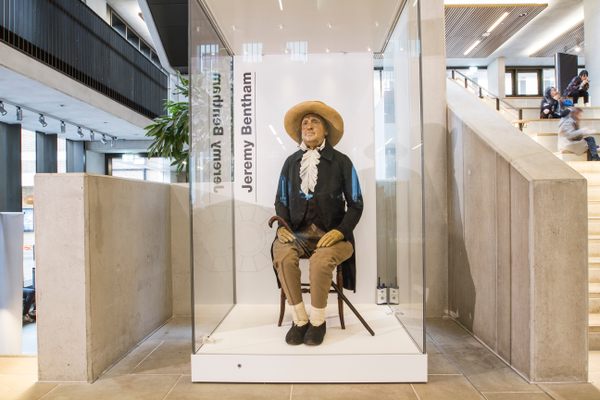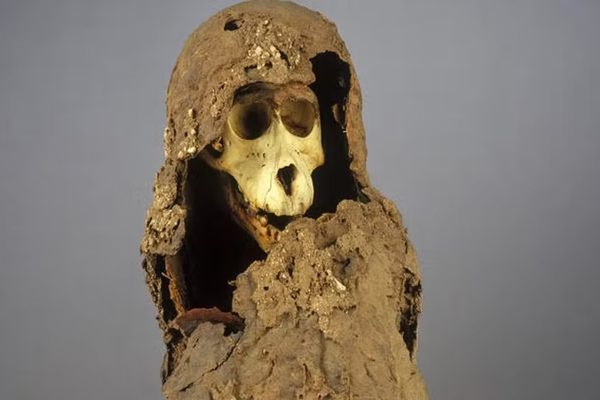Mummy Madness: 10 of the most amazing mummies in the world
 So while Halloween and Day of the Dead are now well past, I still have a bit of ghoulishness that I wanted to share.
So while Halloween and Day of the Dead are now well past, I still have a bit of ghoulishness that I wanted to share.
I had planned to do a Ossuary extravaganza in honor of Halloween, but before I knew it the always excellent io9 had swooped in, found our ossuaries category, and assembled just such a thing themselves, under the fantastic title of “Buildings Where the Walls are Lined with Human Bones”. Of course, I still wanted in on the fun.
In a kind of internet call and response, io9 you say skeletons, we high five you, and shout back mummies! Something for when you want a little more meat on your bones the Atlas Obscura presents: 10 of the best modern mummies, religious relics, and desiccated dead dudes in the world.
Let’s start with a more modern mummy, and one of the more interesting mummies in the world: Jeremy Bentham’s Auto-Icon
1. Jeremy Bentham’s Auto-Icon
When Jeremy Bentham, the utilitarian philosopher behind the phrase “the greatest good for the greatest number,” died in 1832 he wanted to leave something behind.
Bentham asked that his skeleton be “clad in one of the suits of black occasionally worn by me” and seated upright on a chair, with his mummified head on top. This was to be his “Auto Icon.” Unfortunately, the English mummifiers in charge weren’t quite up to the task, and his head was grossly disfigured in the process of preserving it. A wax substitute was created, but as you will note in the picture above, his real embalmed head was placed on the floor between his legs.
For anyone with a pair of anaglyph glasses around we give you mummies in 3D! Thanks to Jeff Hoke at the fabulous Museum of Lost Wonder.
Unfortunately, the head has recently been removed from the case placed in “a safe place” after a number of student pranks involving the mummified head, and as of late it is only his mummified body and wax head that are on display.
From a single modern mummy we go now to a whole gaggle of them. These modern mummies however, were mummified by accident. Welcome to some of the most horrifying looking mummies in the world at the Museo de las Momias de Guanajuato!
These and many, many more mummies after the jump…
2.Museo de las Momias de Guanajuato
Starting in 1865 and lasting all the way until 1958, the small town of Guanajuato, Mexico required that relatives pay a grave tax. When the relatives failed to do so for three years in a row, the graves were promptly dug up and the corpses evicted.
But from the very beginning, when they dug up one Dr. Remigio Leroy on June 9, 1865, they realized something odd was going on. Rather then a pile of bones, the bodies were coming up completely mummified. It seemed that something in the soil was preserving the bodies.
The cemetery kept these strange mummified corpses in an underground – under the cemetery grounds itself – vault in case the relatives came around with the money wanting a re-burial.
Today, the vault has turned museum and displays the dozens of mummified corpses found in the Guanajuato cemetery. The mummies, because they were formed naturally, are much more gruesome looking then your standard Egyptian mummy. With gaunt and twisted faces like extras from a horror movie, and often covered in the tattered rags they were buried in, the mummies stand, lean and recline in glass cases throughout the museum.
Perhaps the most shocking to visitors are the shrunken children mummies. One in particular is claimed to be “the world’s smallest mummy” is no bigger then a loaf of bread.
Our next mummy is perhaps the world’s most famous modern mummy, though most people know little about the tumultuous journey this particular famous mummy has taken.
3. Lenin’s Mummy
When Vladimir Ilych Lenin, the leader of the Bolshevik Revolution, died on January 21, 1924, he did not believe he was going to an afterlife. He assumed that death was the ultimate end for him. How wrong he was.
Though Lenin wanted to be buried, the communist government said there was such a public out cry (they may have had a hand in engineering such outcry) that they decided to preserve the dead leader. The current mausoleum was unveiled in 1930, again designed by Shchusev. Lenin’s body remained here until it was evacuated to Tymen, Siberia (along with his embalmers, who worked to keep it “fresh”), since Moscow was under the threat of Nazi invasion. In March of 1945, a Soviet operation codenamed “Object No. 1” moved Lenin’s body from Siberia back to Moscow.
To continue the preservation of Lenin’s body, a group of special embalmers (originally Ilya Zbarsky and his son Boris Zbarsky) were dedicated to Lenin’s corpse. The sarcophagus is kept at a constant temperature of 16° C (61° F) and humidity of 80 - 90 percent. Weekly, a mild bleach is used to fight discoloring fungus or mold on Lenin’s skin, and every eighteen months the corpse undergoes a chemical bath of glycerol and potassium for thirty days while the mausoleum is closed. During this time, Lenin’s clothes are washed and carefully ironed. And every three years, Lenin receives a new suit.
Sadly, due to the recent economic crisis, the charity that funds Lenin’s upkeep has fallen on hard times and can’t afford to buy Lenin a new silk suit. But then, Lenin would probably cherish the knowledge of capitalism’s global meltdown more then a new suit, anyway.
A strange parallel to the story of Lenin’s body is that of Dashi-Dorzho Itigilov head of Russian Buddhism and seen as an enemy of communism. Like Lenin, Itigilov too went on to become a much venerated mummy.
4. Dashi-Dorzho Itigilov
Dashi-Dorzho Itigilov was the 12th Pandito Khambo Lama, essentially the Dali Lama of Russian Buddhists. The seventy five year old, Itigilov, however was not long for this earth. He announced it was time for him to pass on, asked the other lamas join him in meditation, and then died mid-meditation, three years after Lenin, in 1927.
His sitting body, stuck in the meditation position, was set upright inside a wooden box and buried, where the communists couldn’t get at it. (Not unlike what happened with the evacuation of Lenin’s body, when the Nazi’s invaded Russia.) Shortly thereafter Buddhism was all but wiped from Russia by Stalin and his forces.
In 2002, Itgilov’s body was exhumed (it had been secretly exhumed and checked on twice by the monks during the Soviet era) and transferred to the Ivolginsky Datsan, the most important Buddhist monastery in Russia. Itigilov’s mummified remains are still there, sitting in the exact same lotus position as when he died more than three quarters of a century ago.
Of course if you are looking for religious mummies, the Buddhists have got nothing on the Catholics. Forget one measly mummy relic, try a whole basement full of them.
5. Capuchin Monastery Crypt, Sicily
Pinned to the walls, sitting on benches and shelves and tucked away in open coffins are nearly 8,000 corpses, each one dressed in their Sunday best.
The rooms which house corpses ranging from full mummies to deteriorating skeletons, are divided by the profession the person had in life. There is a room for religious figures, mainly those affiliated with the monastery, for professionals, such as doctors, and a room for women, virgins and infants. The oldest corpse in the macabre collection is that of Silvestro da Gubbio, a friar who passed in 1599.
It is believed that the particularly dry atmosphere allowed for the natural mummification of the bodies. Initially, priests would lay the dead on shelves and allow them to drip until they were completely depleted of bodily fluids. A full year later, the dried out corpse would be rinsed with vinegar before being re-dressed in their best attire and sent to their proper room, to stand for eternity.
One of the most recent to be interred was Rosalia Lombardo, only two years old when she was embalmed in 1920. The embalming procedure has kept Rosalia looking so well preserved that she has been dubbed “Sleeping Beauty.”
However, while some mummies form accidentally and others are created after the death of a person, in a few strange cases, people have begun mummifying themselves while they are still alive. Such is the case of the Sokushinbutsu, the self-mummified monks of Japan
6. Sokushinbutsu, the mummified monks of Japan
Scattered throughout Northern Japan are over two dozen mummified Japanese monks known as Sokushinbutsu. Followers of Shugendu, an ancient form of Buddhism, the monks died in the ultimate act of self-denial.
For three years the priests ate a special diet of nuts and seeds, bark and roots and began drinking a poisonous tea made from the sap of the Urushi tree, normally used to lacquer bowls, and which caused vomiting. Finally, a self-mummifying monk would lock himself in a stone tomb barely larger than his body, where he would not move from the lotus position. Each day the monk would ring a bell to let those outside know that he was still alive. When the bell stopped ringing, the tube was removed and the tomb sealed.
Roughly 28 of these Sokushunbutsu remain, but only 16 of these self-mummified monks can be visited. The most famous is Shinnyokai Shonin of the Dainichi-Boo Temple on the holy Mount Yudono.
The majority of the monks who underwent self mummification did so near this temple. It has been shown that a local spring had high levels of arsenic and this may have helped the monks in the self-mummification process.
It is said that some of the Japanese monks were even buried alive in coffins full of salt to help ensure their mummification. These next specimens were also buried in salt, but in this case, it was a complete accident.
7. The Salt Men of Iran
While bulldozing salt in the Chehrabad Salt Mine, Iranian miners recently uncovered the sixth “salt man” to be found in the last fifteen years. These “salt men” are in fact ancient corpses killed or crushed in the cave, and mummified by the extremely dry conditions. Hair, flesh, and bone are all preserved by the dry salinity of the cave, and even internal organs such as stomachs and colons have been found intact.
The first salt mummy, dated to 300 A.D., was discovered in 1993, sporting a long white beard, iron knives, and a single gold earring. Five others have been found over the last 15 years, with the oldest dating back to an amazing 9550 B.C.
While four salt men have been transferred to the Zanjan Archaeology Museum, and one to the National Museum of Iran in Tehran, (all of which can be seen by the public), the final salt man remains in-situ, half stuck into a mountain of salt.
Of course, salt is only one way in which a body can naturally mummify, extreme cold is another, as in the case of this next mummy found half buried not in salt, but in a glacier.
8. Ötzi the Iceman
“Freeze dried” by the extreme cold and winds, Ötzi, or “Frozen Fritz” as he is sometimes called, lived around 3300 BC and is Europe’s oldest natural human mummy.
Ötzi represents an excellent example of the surprising technological prowess of copper age humans. Surrounded by his gear, the “Iceman” was much better equipped than most modern tourists are for their Alpine hikes. The 5300 year old Ötzi had a copper axe, a bow and arrow, a knife, snowshoes, some antibacterial mushrooms, and a what appears to have been a complex firestarting kit including “tinder fungus” a mushroom that bursts into flame when struck with sparks.
Researchers are unsure of how exactly Ötzi died but an arrowhead was found lodged in his shoulder, a deep cut on his thumb, and DNA evidence suggests he was covered in the blood of four others; in other words Ötzi went out fighting. It is likely that Ötzi was part of a raiding party and was killed in a violent skirmish that led to his death. His last meal before he died: some fruit, grain, and Chamois.
In movies mummies are often portrayed as evil, preying on humans. But he next mummy highlights how Egyptian mummies were in more danger from the living then vice-versa and how mummies went from mysterious Eastern corpse to an afternoon snack for rich Europeans.
9.Mumia Head of the Golden Eagle Pharmacy
The Golden Eagle Pharmacy Museum in Budapest, Hungary has a number of odd an interesting items on its shelves, but none more so then the box of “mumia” complete with a withered mummies head on top.
Due to a translation error (from the Arabic word mumia meaning tar or bitumen) it was believed by medieval alchemists that the powder of ground up mummies was a cure all. In the 1100s these alchemists began shipping in cheap Egyptian mummies by the dozens to be ground up for salves, potions and other “cures” sold to wealthy Europeans. Soon mummy powder was being prescribed for everything from epilepsy to upset stomachs.
In the 1500’s mummy was big business. Anyone who was anyone used mummy. Francis Bacon loved it, so did Francis I of France. Shakespeare wrote about it in Othello and Macbeth, while his son-in-law John Hall prescribed it to his ill patients. Aristocrats carried around powdered mummy in a small pouch just in case they should begin to feel under the weather.
Eventually the mummy trade died out, not due to disgust but to lack of supplies. The above photo is of a Guanche mummy one of the few remaining that wasn’t ground up for use as mummy powder. Mummy was still available in the Merck catalog as late as 1908. “Genuine Egyptian mummy, as long as the supply lasts, 17 marks 50 per kilogram.”
But while the mummy trade was in full swing and Egyptian and Guache mummies were being ground into dust, mummies were being collected by the Catholic church in Europe. Known as “incorruptibles” and venerated as holy relics, this is the origin of our next and final mummy.
8.Saint Catherine of Bologna
Most visitors would miss the nondescript wooden door near the left of the entrance entirely. The curious among them might be bold enough to ring the doorbell. Those who do will find themselves buzzed in, and at the end of a corridor, will come face to face with the mummified relic of St. Catherine of Bologna.
St. Catherine was said in life to have been visited by visions of God and Satan, and was tormented by gruesome visions of the crucifixion, the last judgment, and the devil’s tricks. When she died in 1475, Catherine was buried in the nun’s churchyard without embalming or a coffin. Although no flowers were placed around her grave, it was said that flowers could be smelled all around for days afterward.
When her sisters exhumed her body, 14 days after burial, she was found to be, according the the church’s pamphlet, “intact, flexible, and sweet-smelling.” She has been sitting in her Golden Throne in the small chapel of the Cheisa della Santa ever since, or roughly 535 years. Her tight, almost featureless skin is said to have turned black from the soot of centuries worth of burning candles.
That brings us to the end of this edition of mummy madness, despite there being many other excellent mummies (Bog mummies, Incan mummies, mummy Juanita, Lady Dai!) worth featuring. Sadly these will have to wait for another list, for another time.
Check the Mummies category of the Atlas for another 15 or so mummies that didn’t make the cut, and if you find one missing, or know of a great mummy that you think should be on the next list please list it in the comments or better yet, enter it into the Atlas!
And with that, the list of the 10 best modern mummies, religious relics, and desiccated dead dudes in the world, is a wrap…























 width=”540” align=”center”>
width=”540” align=”center”>












Follow us on Twitter to get the latest on the world's hidden wonders.
Like us on Facebook to get the latest on the world's hidden wonders.
Follow us on Twitter Like us on Facebook